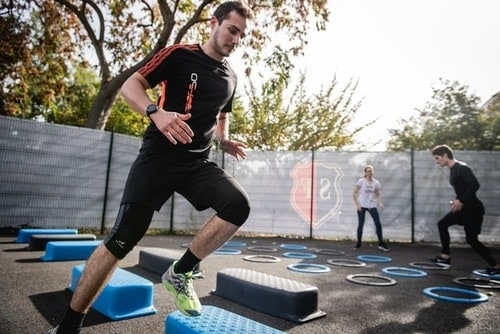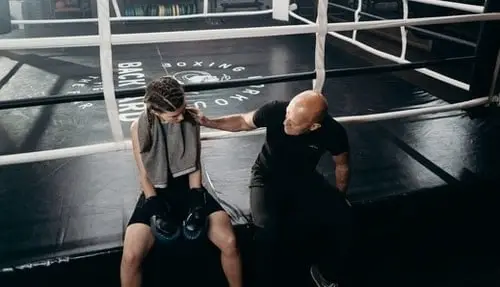So you’re thinking about becoming a personal trainer but you want a sneak peek at what you’ll be learning in your courses?
Well don’t worry, I’ve got you covered, I’m a fully certified personal trainer, I’ve taken and passed a whole bunch of exams, so I can tell you exactly what personal trainers learn and how to best study for each to guarantee you get your certification.
Sound good?
Let’s go…
Before we get started, the good news is that passing the exams to get certificated as a level 3 fitness instructor or personal trainer really isn’t that difficult, and passing the gym instructor course is pretty easy too, so what you’ll be learning won’t be too taxing either.
I know that when I first got handed my training booklets explaining all the modules and exams I needed to study and take, I was pretty intimidated, I had no idea what I was doing and I’d never heard of anything I was reading.
Let’s take all of that uncertainty away by explaining what you’ll be learning in your modules. I’ll explain what you’ll be learning and throw in a quick few study tips for you.

Content in this article
Level 3 personal training certification
- Level 3 Certification Modules
- Advanced anatomy and physiology
- PT program design and coaching techniques
- Nutrition and weight management
- Advanced resistance training
- Behaviour change principles
- Personal training business skills
- Lifestyle management and motivation
Level 4 personal training certification
- What do level 4 personal trainers learn?
- Strength and conditioning
- Speed and agility training
- Power training programming
- Macro and micronutrient guidelines and supplementation
- Client coaching strategies
- Lower back pain management
- Obesity and weight management
- GP referral
- Client Rehabilitation
What Modules Are Included In Level 3 Personal Training Certification Courses?
I’ve scoured the internet and read the prospectus for just about every training company out there, and most companies are offering variations of the same main modules, so here’s a list of the personal training basics you’ll learn when you start studying for certification as a level 3 personal trainer.
- Advanced anatomy and physiology
- PT program design and coaching techniques
- Nutrition and weight management
- Advanced resistance training
- Behaviour change
- Personal training business skills
- Lifestyle management and motivation
If you’ve already passed your gym instructors course (something you’ll need if you want to be a fitness instructor or personal trainer), you’ll notice that a lot of these courses sound pretty similar to what you’ve already learned.
The truth is, they pretty much are, but they’re more advanced and delve a lot deeper into the subject matter.
For example, in your gym instructor training, you get taught how to set up exercise machines and how to demonstrate their safe usage. Whereas, in your level 3 course, you’ll be taught how to write up much more advanced exercises using free weights, and how to spot, encourage and motivate your own clients during their workouts.
The main focus of your level 3 certification, has shifted from helping members in a gym understand how to use equipment safely on their own and teaching basic classes, to giving a far greater level of service to your own clients.
The modules may look similar, but each module is far more advanced in its teaching, and what you’re learning is a complete skill set to successfully run your own business.
Advanced anatomy and physiology

You will have already learned the basics of anatomy if you’ve got your gym instructor (level 2) certification, but level 3 takes things a step further by going into much greater detail.
You’ll read booklets, attend classes or webinars that explain in-depth muscular and leverage systems, planes of movement, the nervous, endocrine, and energy transport chains.
It’s important that you know these systems because it will help you understand why exercises are prescribed and how the muscles and joints work together as a complete system.
Understanding these concepts not only helps you to prescribe the most effective exercises and programs for your clients but allows you to prevent any potential problems caused by training, for example, being able to see and understand the symptoms of overtraining and how it affects the nervous system is vital to prevent your clients becoming ill from overexerting themselves.
Nine times out of ten you’ll be handed reading materials to read in your own time, however, there may also be online training supplied by your course provider.
Study tips
I would advise you to give this module a considerable amount of your attention and dedicate at least an hour or two a night to studying it. You’d be surprised how complicated some of the information you will be learning in this module can be, for example, you’ll be taught about leverage systems and will need to know which types of lever systems different parts of the body use.
PT program design and coaching techniques

As a personal trainer, you will not only be prescribing more complicated exercises (deadlifts, squats, etc), but you will also be present with your clients throughout their workout, so you’ll be taught how to encourage and motivate people whilst they exercise.
Being able to properly motivate a client during, before, and after each workout is a very important step to their progress. An unfortunately high number of people quit using the gym after only a few months of training on their own, usually as a result of a lack of results. Motivating and encouraging your clients to continue pushing themselves is one of the most important parts of being a successful personal trainer.
You will be taught how to use more complicated training programs and methods, such as periodization, supersets, pyramid sets, etc. These training styles can be used to help you achieve far greater results with your clients and make them more time-efficient.
You’ll usually attend classes (either physical or webinars) for the coaching parts of your training, with the program design being taught through the use of handouts and booklets.
Study tips
The best way to practice for a module like this is to try it out on your friends and family, it might feel a bit strange, but get used to asking people about their goals and creating exercise programs for them. In terms of coaching, if you already go to the gym, you can try out what you have learned by motivating your friends, or by motivating yourself by imagining you were talking to a client.
As long as you are getting yourself into the right headspace when you’re in a gym and thinking like a trainer, you will become much more comfortable and confident with it.
Nutrition and weight management

Every course is different, but they will all have some sort of in-depth nutrition and weight management sections. How detailed they get is down to the course provider, but the information will certainly feature, so if you’re wondering if personal trainers learn about nutrition, the answer is undoubtedly, yes.
Nutrition and diet is a tricky subject for most personal trainers, as they are usually advised not to give out any specific dietary or nutritional advice unless they are certified as a dietician or nutritionist.
Despite this, it’s vital to any personal trainer’s success that they fully understand at least how the systems within the body, work and what kind of an impact diet and nutrition make on a client’s progress.
The training you receive in regards to in-depth diet and nutrition is more for the trainers own understanding rather than to dish out advice.
Without fully understanding the role food plays, a trainer cannot fully expect to help their clients either gain, lose or maintain body weight or alter and shape their bodies as they wish.
The way you’ll be taught nutrition and weight management will nearly always be from handouts and booklets for you to read and study at your own leisure.
Study tips
Again, this module can get complicated pretty quickly!
I would recommend you spend at least an hour a day reading through your materials or studying online, as the exams you have on this subject will all need precise answers. If you are new to bodily systems and haven’t studied biology before, you may struggle to understand some of the systems and their interactions if you don’t give the information ample time to sink in.
Advanced resistance training

In the advanced resistance training section of your course, you’ll be introduced to more specific ways to train your clients, such as using plyometrics, negative reps, isometrics, and so on. These training styles go far beyond the standard understanding of most gym-goers.
You’ll also be introduced to overload, progression, adaptation, and specificity principles to ensure your clients are consistently making progress from their training.
You may find modules that feature other concepts such as core and balance training.
The advanced resistance training methods will move away from the machines based exercises that level 2 certified trainers will have been taught and will focus more heavily on free weights. This is because, as a trainer, you are expected to know how to train people in the more complicated exercises that require attention to detail and a deeper knowledge of correct lifting techniques.
You will usually be taught advanced resistance exercise techniques by attending either a 1 day or weekend-long training course at a gym local to you
Study tips
Here’s where the internet can really help you out!
The information you will be taught about how to instruct exercises such as deadlifts will take place over a weekend or even a single-day workshop, so it’s pretty easy to forget what was said. If you find this is the case, there are almost unlimited resources online that show the proper techniques for the big lifts such as deadlifts and squats.
The practical exams you will take to get your level 3 cert will have you training a buddy, so the ideal way to practice and study for this module is to read any accompanying reading materials, takes plenty of notes during your workshops, research correct lifting techniques online from reputable sources and then to practice demonstrating them to your friends or in your mind.
Behaviour change principles

As a personal trainer, your role is far more complex than simply prescribing exercises with their sets and reps. You will act as a coach, a phycologist, and an agony aunt.
You will develop a strong connection with your clients, and it is part of your role to help establish positive habits that replace negative ones and to advise and illustrate what benefits the client will get from making positive changes to their lifestyle.
Many of your clients will have thoroughly ingrained habits that need to be overcome if they are to make any considerable progress from your training, and this is something you will be taught how to achieve.
For some, negative health habits can develop as coping mechanisms for much larger issues in their life. Whilst it’s not your role to address these bigger issues, you can certainly help to show them how important exercise and living a healthy lifestyle can be to them, and the positive changes it can make to their physical and mental wellbeing.
You will usually be taught behavior change modules through handouts and reading materials for home study.
Study tips
These modules never seemed too complex to me, they are certainly not training you up to be a psychologist, it’s more about learning how to understand how other people think and how that may be entirely different from your own ways of thinking.
I would say give this as much time as you need, but half an hour an evening or so, (depending on when your exam is), should be enough for you to understand the concepts presented here.
Personal training business skills

This should be a module on every personal training certification. The good news is that more and more companies now seem to be adding this vitally important module to their courses.
Without a thorough understanding of how to maintain and grow your PT business, you will struggle to make money and your business could even fail.
Within this module, you should expect to be taught personal training marketing tactics both inside and outside of the gym, and sales skills (including how to obtain consultation sessions and how to close the sale after it’s completed).
Other important aspects that will be taught are budgeting and managing your personal finances. This will show you how to determine the number of sessions you need to deliver, and at what price per session in order to cover all your fees and make a consistent profit.
This information will likely come in the form of handouts and various reading materials for self-study, although online training may also be offered.
Study tips
You’re going to have an exam based on this module, but, I am going to go out on a whim and say that whatever you taught in this module will still be nowhere near enough information to succeed in the dog-eat-dog world of personal training.
Study your materials, take your online courses, or however else the information is given to you, but my advice here is to study and study and study personal training marketing and business skills, they are the make or break of most businesses and a lack of knowledge in this area is almost certainly responsible for the massive 90% turnover rate of trainers new to the industry.
Lifestyle management and motivation

A huge part of being a personal trainer is finding a way of stripping away your clients’ excuses for not making change.
This can be very difficult as some people will always find a reason why training “just doesn’t work for them”. Nine times out of ten, you will find that your clients will be working until late each night, snacking, and frequently going out with friends after the workday is done.
This kind of excessive lifestyle will make it next to impossible for any noticeable results to be attained. It is up to you as a trainer to explain that lifestyle changes need to occur and to go about this in a way that doesn’t put them off from training or come across as confrontational, which can be a difficult thing to achieve in some cases.
It’s also very common for clients to want to give up, (for the same reasons as mentioned above), so it’s very important that you are taught how to effectively motivate your clients, show them the progress they are making and keep them on the right path.
You must really understand your client’s “why”, as by knowing their main motivations for training, you are more easily able to explain why negative aspects of their lifestyle need to be changed and increase their own motivation for attending training sessions.
Again, you will usually be taught this module with reading materials and handouts.
Study tips
This module is a lot more important than it may seem at first glance. I would, of course, suggest you read and study all the information given to you, but I would also suggest for the exam (and continuing afterward) you study a lot more online about behavior change, CBT, and other ways of shifting peoples negative focus onto a more positive one.
You’ll lose a lot of clients that give up if you can’t show them that they are making great progress with you, and a lot of the achievements made in the gym come from having the correct attitude in the first place.
You should dedicate some considerable time to this one!
What do level 4 personal trainers learn?
The next step up from your level 3 status is unsurprising, the level 4 certification!
Not many people in your average box gym will opt to go for this level, the majority of the time, you can get by just fine with level 3 certification. The courses can also be fairly time-consuming and fairly expensive.
You’ll pick up plenty of clients from the minimum requirement to work as a PT (level 3 certification), but some people just like to have that extra bit of knowledge. You can possibly add a little extra to the cost of your training sessions if you can demonstrate that you are worth the extra money due to being more qualified, so this offsets the initial costs in some people’s minds.
So is the level 4 certification worth the extra time, money, and effort to get? Let’s see what you’ll be learning so you can make up your own mind and decide if it’s for you or not.
Level 4 personal training modules
- Strength and conditioning
- Speed and agility training
- Power training programming
- Macro and micronutrient guidelines and supplementation
- Client coaching strategies
- Lower back pain management
- Obesity and weight management
- GP referral
- Client Rehabilitation
Strength and conditioning

Gaining a qualification as a strength and conditioning coach allows you to work specifically with athletes to improve their speed, strength, power, and endurance (depending on the sport they are training for).
One major advantage of becoming qualified as a strength and conditioning coach as well as a personal trainer is that it allows you to work in two separate fields and move from one to another as you wish.
Should you get tired of working with the general public in a personal training capacity, you could use your certification to move into the world of training sports people exclusively. Of course, if you wish, you would also be able to pursue both at the same time if you have the capacity to do both.
You will need to structure personal training sessions that take into account the sports persons needs to be at the top of their chosen sport at any given time, prevent injury and motivate your client to push themselves far harder than they would usually be willing to go in order to get the best results from your training.
You will sometimes be working with just one athlete at a time, however, you may also find yourself becoming the sports coach for an entire team.
In order to become a strength and conditioning coach, you would usually need to have a bachelor’s degree in an exercise-related field, but more and more certification providers are starting to add strength and conditioning coach accreditation to their courses.
What you’ll learn in your modules
- How to find new, credible, and reliable coaching materials and guides.
- How to assess and measure an athlete’s performance, and be able to perform these assessments routinely and accurately.
- How to deliver world-class strength and conditioning coaching sessions.
- How to structure and deliver periodised training programs.
- Nutritional requirements for sportspeople and athletes.
If you decide to take the Bachelor’s degree route, this will usually take place in a university. If you choose to use a certification provider, you will be doing most of your learning via an online course.
Study tips
This one is pretty obvious, if you can find a friend or family member, you can practice what you have been taught through your reading materials and classes. Experiment with measuring their performances, decide how you would improve it, write up training programs, etc, the more practice the better.
Bear in mind that these level 4 courses are far more advanced than the level 3 certifications, so you will need to spend a lot more time studying and researching them.
Speed and agility training

Continuing on from the sports and conditioning modules, you will learn how to increase your client’s speed and agility to improve sports performance.
You’ll learn how to utilize plyometric (explosive) exercises, along with sprint drills, Olympic lifting techniques, and other large muscle group exercises to develop strength and power in your athletes and clients. You’ll also be taught speed and agility techniques such as resisted sprinting, sprint mechanics, and lateral speed change drills to ensure your clients are competing at their maximum capacity.
Study tips
Along with researching the benefits of each component of this course, I would recommend you give each of them a try for yourself. Even if you are a bodybuilder, if you are going to be teaching someone how to improve their athletic performance, it’s going to be a lot easier if you understand what it actually feels like to perform the exercises you are prescribing.
A lot of these exercises are pretty good fun, so you can add them to the end of your regular workouts as a bit of learning on the side.
Power training programming

Not all athletes need to focus on speed and agility, for certain sports and clients, raw power is the goal.
Not to be confused with strength, power refers to explosive, high force, and velocity movements. You’ll learn how to create programs and routines that improve the body’s use of as many muscle fibers, as explosively as possible.
One method of increasing explosive power in an athlete is to superset (put two exercises back to back) that make use of different muscle fibers. For example, you could have a client perform a set of 5 near-maximal lift squats, then follow it immediately with a plyometric movement, such as box jumps. This superset makes use of both slow-twitch (type 1) and fast-twitch (type 2) muscle fibers.
In your training, you’ll be taught how to create training programs such as these, whilst also making sure your clients train in the safest way possible to avoid injury.
The elements you are taught from this course are not necessarily specific to sportspeople, as they can be used within a periodization program for standard clients to make their training programs more interesting and effective.
Study tips
Much like the speed and agility training, I would heavily advise you to give these techniques a try for yourself. It’s important for you to know how your clients will be reacting to the exercises you prescribe because it allows you to judge correctly what kinds of weight to start them with, and just how tiring they can be.
If you’ve never tried the exercise out yourself, you may think your client is being lazy, when in reality, what you have prescribed could be completely exhausting.
Trying the exercises out for yourself will also help you more accurately prescribe exercises for specific training goals.
Macro and micronutrient guidelines and supplementation

The level 4 personal training courses take nutritional knowledge a step further, by introducing you to far more complex and intricate bodily processes involved with the digestion and metabolization of both macro and micronutrients.
You will be taught the functions that these nutrients play within the body and the benefits they have on your clients’ training regimes, along with how to adequately adjust your clients’ diets to take into account macro and micronutrient deficiencies and dietary diseases such as type one and type two diabetes.
And you will learn how to calculate energy requirements to suit your clients’ goals (weight gain, weight loss, or maintenance). Some course providers may even teach you how to create meal and menu plans that you can offer to your clients to aid in their progress from training.
Study tips
The exam for this is tough and needs a thorough understanding of the concepts taught in your reading materials. I would suggest you stick to the information that has been provided to you and not research too much online, as nutrition can quickly become a rabbit hole of theories and myths.
The information you are taught in level 4 nutrition will be far more complex, so you will need to dedicate a considerable amount of time to this if you want to score highly on the exam.
Give this one plenty of study time.
Client coaching strategies

The client coaching strategy modules take you from personal trainer territory into fitness coaching, by teaching you phycological techniques to motivate and encourage your clients.
Clients’ willpower is easily broken, and by learning how to effectively assist your clients through tough points in both their training and their lives outside of the gym, you are more likely to help them achieve their goals and retain them as clients for longer.
By using coaching techniques, you can show people how to see the bigger picture and look at the long-term benefits of exercise and nutrition, you can also, very importantly, teach them how to be accountable for their actions and increase their focus.
Study tips
Not much that you’ll need to study other than what you are given in your reading materials or online training sessions, again, like nutrition, this could easily become a rabbit hole of different views on the best practices for coaching clients, so in order for you to pass the exams, I would stick to the materials you have been given.
They shouldn’t be too complicated, so still, give it as much time as you can afford to, but this module shouldn’t be anything to worry about.
Lower back pain management

Due to the sedentary lifestyles that the majority of the population now live, lower back pain is becoming more and more prominent. Lower back pain is a complicated issue to diagnose and correct, therefore, for many personal trainers of level 3 status, it’s too complicated of an issue to work with, so many potential clients would need to be passed onto a more advanced trainer.
By taking this module, you’ll be taught the main culprits that cause lower back pain and discomfort, and then how to address and correctly treat them. You may even find yourself with the opportunity to work with a chiropractor or doctor to help people with chronic lower back pain.
You’ll learn, what the different types of back pain are caused by, how to test and assess your clients to discover what is causing their pain and create treatment plans for them, along with postural analysis and correction techniques.
Having this qualification can be a fantastic way of making considerably more than the average trainer, as a huge percentage of the population suffers from this debilitating condition, that very few trainers possess the certification to treat effectively.
Study tips
First off, I would absolutely NOT recommend practicing any techniques you are learning on anyone with lower back pain problems until you are fully confident and qualified. You could find yourself getting sued if you make someone’s pain worse because you didn’t fully understand what you were doing.
There’s no reason why you couldn’t start to practice looking at people’s postures and assessing them to see if you can spot any abnormalities and considering what methods you would use as treatment and then seeing if that matches up to your training documents state.
Again, stick to the booklets on this one, learn the information and give them the answers they are looking for and not your own opinions or what you have read on a forum.
Obesity and weight management

Obesity is on the increase year in year out all over the world and is fast becoming one of the main contributors to premature death. As a result, it is quickly becoming one of the most sought-after specializations of personal trainers.
Treating clients that are obese is very different from training an overweight person, as there are far more considerations to take into account when designing a weight loss program for them. For one, you will have to be very careful to not push an obese client too hard in the initial phases of training as their heart rate could reach dangerous levels, a slow and steady approach must be taken when treating individuals with this condition.
You will also need to be aware that exercises that many of your clients find easy, (such as squats or lunges) would be considerably harder for a larger person to execute safely. You would also need to pay close attention to exercises and movements that put excessive pressure on their joints, as they are likely to injure themselves because of increased load.
You will usually be taught how to assess and manage clients that are obese and how to manage common dietary illnesses associated with obesity, such as type 1 and type 2 diabetes, dietary advice and recommendations, and the phycological and physical causes of obesity in individuals.
Study tips
Not too dissimilar to the diet and weight loss modules of level 3 certifications, this module will mostly take what you learned and add a few caveats to it, such as exercise regressions for obese clients. You’ll be taught all of this in your reading materials as well as common diseases caused by obesity and weight management issues in your reading materials, so you won’t need to do too much external research.
You can of course do your own research, but you don’t want to stray too far from what your examiners will be looking for as answers to the questions they will give you in your tests.
GP referral

An excellent way of building a client base from outside the gym is with the GP exercise referral accreditation. In these modules, you’ll learn how to treat common conditions caused by sedentary lifestyles and poor diets, such as diabetes and obesity, and a host of other medical conditions and recovery programs.
The GP referral certification allows you to receive referral patients from both GP’s and NHS staff (in the UK).
In this module, you’ll learn how to treat specific medical conditions that can be improved through diet advice and exercise instruction, such as diabetes, high blood pressure, arthritis, and some mental health conditions such as anxiety.
You’ll be taught how to design and instruct exercise programs that tailor to the specific conditions of the clients you are treating with exercise contraindications thoroughly considered.
And finally, you will be instructed on how to set realistic and attainable goals within the desired timeframe for either the trainer or client.
Study tips
For a GP or doctor to have the confidence to recommend you as a trainer to assist their patient, you are going to need to be highly knowledgeable in a multitude of injuries and diseases that can be influenced and improved through exercise.
This module can be pretty tough, so I advise you give this one some considerable time too. You’ll not only need to understand what exercise types help certain conditions but also why they help. It’s not a simple module.
Client Rehabilitation

Injuries occur, and a client getting injured halfway through a training program is a great way to find yourself with an empty session slot for the next few months.
The aim of client rehabilitation is not only to ensure that your clients don’t get injured in the first place (that should be standard), but it to be able to treat them through any injuries that do occur and to be able to take on clients with pre-existing injuries.
Often, a prospective client will tell you that they would love to begin training, but they can’t due to lower back pains, cruciate ligament damage, or a torn rotator cuff. In this example, you would be able to take on this client to help them with their long-term goals, as well as treat their current injuries.
The rehabilitation modules will not only teach you how to provide treatment for injuries, they also give you the knowledge to treat people who are in need of rehabilitation due to illnesses such as cancer and COPD. Having a trainer to help these people regain their strength can be of huge benefit, not only physically, but also mentally.
You will learn how to treat a large array of injuries and medical conditions with prescribed exercise, as well as understanding unwanted side effects of excessive or strenuous activities on an individual that is currently going through the healing process.
Study tips
Like some of the other modules in the level 4 certification module, client injuries can become a very large area to study very quickly. For this reason, I would again suggest that you only stick to the information you have been provided and learn it thoroughly.
After you have passed the exams, feel free to study as many injury prevention and treatment plans as you wish, but remember that you don’t need to be a qualified physiotherapist in order to pass this section, but the topics will be complex, so dedicate yourself to learning only what you need to for now, and then progress your own learning after.
Conclusion
So there you have it, personal trainers have a lot of options in terms of what they can learn and get certified in. There is absolutely no need to become qualified in all these fields, they are only options, and you should pick what works with you as a person and not be driven by the potential financial gains certifications could bring in.
If you aren’t genuinely interested in treating obese clients (for example), you won’t enjoy your role as a trainer, so make sure you stick to what you enjoy.
You can certainly take the level four certification if it’s something you want to study, however, from my own experience, there are plenty of trainers that have the basic level 3 certification and make a great living as a PT, and love their job, so don’t be convinced by companies that you need all these certifications in order to be successful.
There are of course other additional courses that personal trainers can take, such as branded strength training programs, but I will leave those for a separate article.
I really hope this article has given you a full insight into what personal trainers learn to get certified.
Have a great day!
If you enjoyed this article and feel it might help others, please feel free to share it or link back to it.
